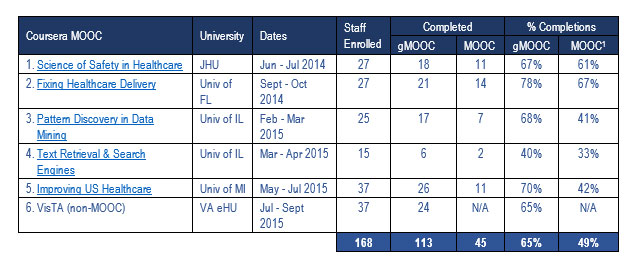Do you MOOC? Could you? Would you gMOOC?

The phrase corporate training may sound like, well, school, but in the hands of Lara Van Nostrand, it is anything but. Her team sets up collaborative learning experiences that take advantage of online classes held elsewhere (e.g., Coursera), interactive survey technology, and MITRE’s collaboration and social media tools. A metric for success: Participants not only start the classes, they finish them. —Editor
Author: Lara Van Nostrand
The MITRE Institute posed the question “Do you MOOC?” to our MITRE staff in November 2012 to explore the appetite staff had for taking online courses. After explaining that a MOOC was a Massive Open Online Course, we discovered that 82% of the almost 700 respondents wanted to participate in online training of this sort. The response was not surprising since MITRE staff in general have a high affinity for continual learning. MOOCs provide easy access to credible content anytime/anywhere from reputable institutions, often at no financial cost.
However, as discussed in this Washington Post Sept 2015 article, completing a MOOC solo can be challenging. MOOCs require a high amount of self-motivation and come with a limited amount of accountability. The consequence or cost to the student in terms of not completing the MOOC coursework is minimal, and the time investment spans several weeks. That said, we wanted to find a way to help MITRE staff optimize their learning outcomes while participating in a MOOC. This is how the idea of a gMOOC or “Group MOOC” was born. A gMOOC provides a space for approximately 15-30 MITRE staff to connect and collaborate while they are enrolled in a MOOC hosted by another institution such as Coursera or EdX. A gMOOC provides direct connection to other MITRE staff, a sense of accountability, an opportunity to discuss what one is learning and ask questions, and a chance to network with other MITRE staff who share similar interests and/or could be a subject-matter-expert (SME) on the topics discussed.
As part of MITRE’s Knowledge Driven Enterprise, gMOOCs help MITRE “bridge knowledge and technology” by leveraging collaborative tools and instructional design. A gMOOC includes two primary components that mimic the MOOC delivery and provide synchronous and a-synchronous channels for connection with MITRE colleagues:
- Weekly lunchtime sessions aligned with the time span of the MOOC. The MITRE Institute conducts these sessions virtually using our internal web conferencing system, “SKYPE for business,” and include MITRE SMEs as facilitators and presenters. During the sessions, we encourage staff engagement via interactive polls.
- An online discussion board housed in a SharePoint blog. As part of the gMOOC requirements, students are required to post on the blog. Facilitators encourage staff to continue the conversation started in the synchronous sessions by posting online via the discussion board.
Above and beyond the MOOC, a gMOOC creates a more focused experience. MITRE staff are able to more directly connect with a smaller group of 15-30 MITRE colleagues, in addition to reaching out to the more massive community of all MOOC participants. This can foster an increased sense of accountability and motivation. Additionally a gMOOC helps address motivation by demonstrating the relevance of the MOOC topic to current MITRE projects and challenges via presentations by MITRE SMEs.
Since June 2014, we’ve offered five gMOOCs using Coursera content–three for health-related topics and two for data science. We’ve also applied the gMOOC model with non-MOOC content – leveraging content from the Veteran’s Affairs Electronic Health University. For our next gMOOC, we plan to leverage a Specialization Series from Georgia Tech on Healthcare Informatics due out in late 2015. Enrollment and completion rates have been positive, with almost 50% of the staff who complete the gMOOC also completing the MOOC. See the table below. Feedback has been encouraging as well:
- I liked the format. It provided a forum to hear firsthand what MITRE is doing in this area from the people working in it and the opportunity to ask questions.
- LOVED the speakers, the variety in topics and technicality …, and the interactive pulse surveys.
- The guest speakers provided a deeper meaning to the Coursera course work, which was dry at times but the guest speakers helped tie loose ends.
- The course material is videotaped, so the interaction with real people was great for me.
- The Group MOOC allowed us to bring real examples of MITRE projects and portfolios and align them to the course topics.
- I don’t think I would have listened to every lecture or completed the course assignments without having a group MOOC each week.
Now that you know more about MOOCs and gMOOCs, “Would you gMOOC?” Let us know your thoughts. 
[1] The percent of gMOOC students who completed the MOOC. For example 11 out of 18.
© 2015 The MITRE Corporation. All rights reserved. Approved for Public Release; Distribution Unlimited. Case Number 15-3070

0 Comments